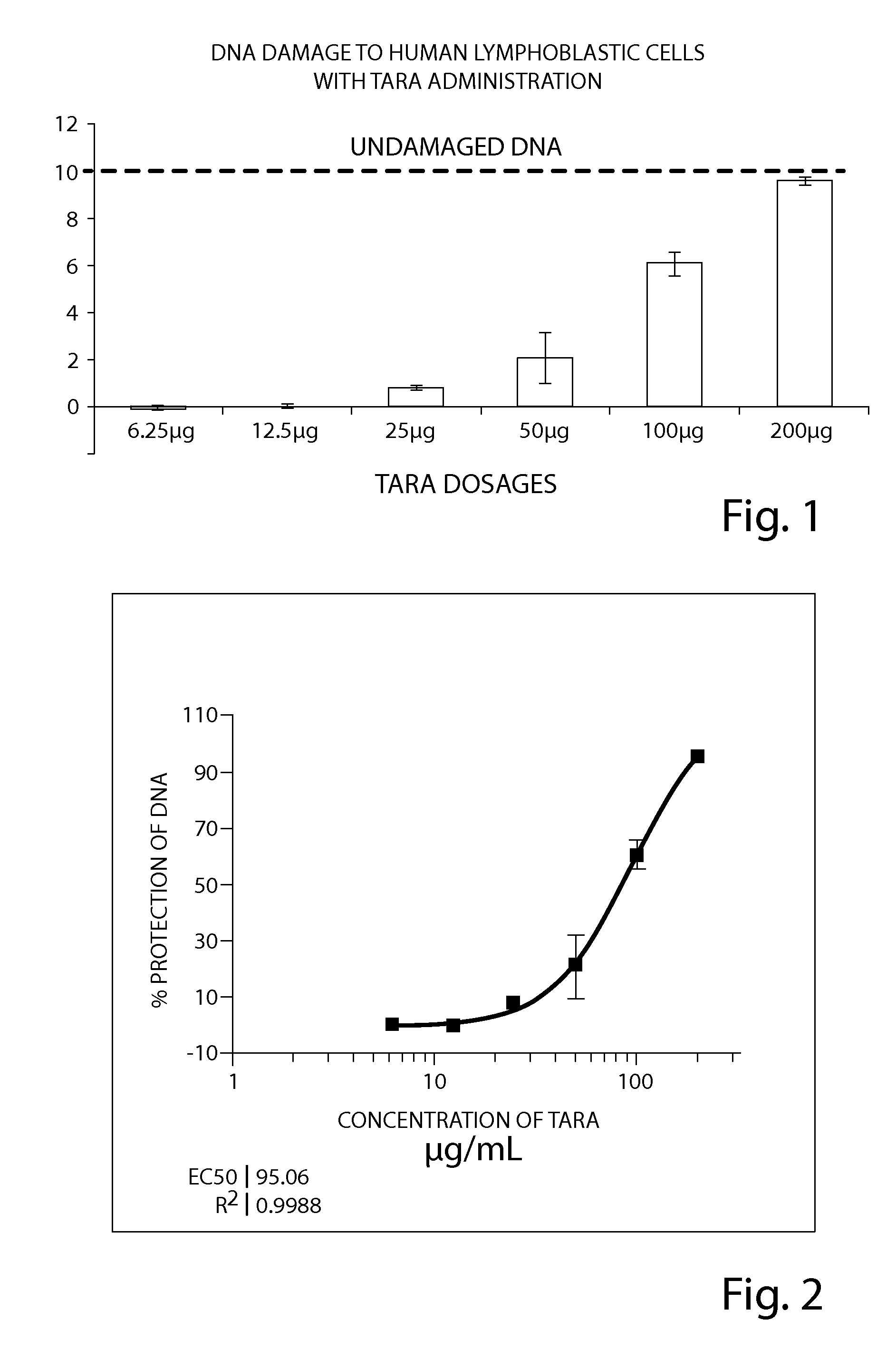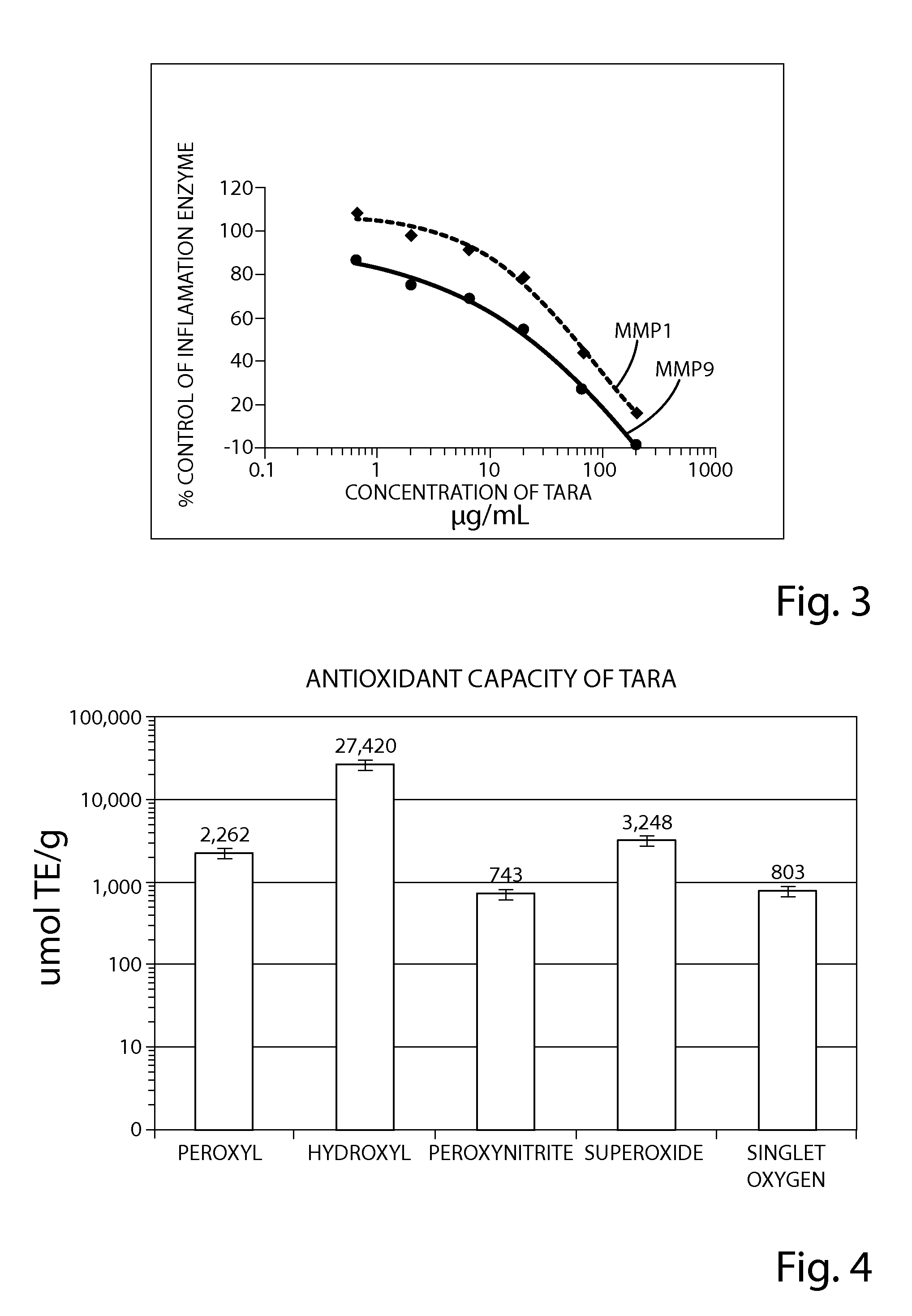Anti-inflammatory and antioxidant composition and related method of use
a technology of antioxidant composition and composition, applied in the direction of drug composition, antinoxious agent, metabolic disorder, etc., can solve the problems of undesirable mutation, dna damage, chronic inflammation, etc., to reduce or eliminate inflammation, increase antioxidant capacity, neutralize or reduce free radicals
- Summary
- Abstract
- Description
- Claims
- Application Information
AI Technical Summary
Benefits of technology
Problems solved by technology
Method used
Image
Examples
example 1
[0027]To analyze the effect of the composition, and in particular the Tara extract, on DNA protection an assay was performed. To test DNA protection, a single cell gel electrophoresis assay, also known as comet assay, was performed to detect DNA damage of eukaryotic cells, and in particular human lymphoblastic cells, pre-treated with the Tara extract. The comet assay is described in Singh et al (1988), Experimental Cell Research, 175(1):184-191, which is hereby incorporated by reference. In the assay, human lymphoblastic cells were prepared according to the standardized method for a comet assay as presented in Singh et al., and pretreated with different amounts of Tara extract, specifically, 6.25 μg, 12.5 μg, 25 μg, 50 μg, 100 μg, and 200 μg of Tara extract for one hour. The cells were washed and treated 100 μM of hydrogen peroxide for 20 minutes. The cells treated with the hydrogen peroxide exhibited different levels of DNA damage depending on the pre-treatment with the Tara extrac...
example 2
[0031]To analyze the effect of the composition, and in particular the Tara extract, on inflammation, the following assay was performed. Generally, the inhibition of certain enzymes responsible for inducing inflammation was measured to determine the effectiveness of Tara extract. In particular, MMP1 and MMP9 enzyme inhibition was measured in the assay. Conventionally purified recombinant MMP protein, commercially available from EMD Biosciences of North America, was combined with fluorogenic peptide substrate IX, commercially available from R&D Systems of Minneapolis, Minn., in the presence of varying concentrations of diluted Tara extracts, as indicated by the points on the graph at FIG. 3. The conversion of the fluorogenic peptide substrate over time was monitored with a fluorescent plate reader, particularly a SpectraMax M5 plate reader, which is commercially available from Molecular Devices, LLC of Sunnyvale, Calif., United States. The data were collected, and the Vmax for each we...
example 3
[0033]To analyze the antioxidant effect of the composition, and in particular the Tara extract, its ability to neutralize multiple major free radicals was investigated. In particular, Tara extract in varying concentrations was tested in conventional peroxyl, hydroxyl, peroxynitrite, superoxide and single oxygen assays. The assays included individual testing of peroxyl radical, hydroxyl radical, superoxide radical anion, singlet oxygen, and peroxynitrite anion. The assays were performed at Brunswick Laboratories, of Southborough, Mass. The antioxidant capacity for each parameter was quantified using area-under-the-curve kinetic analysis, such as those disclosed in Dubost, Ou, & Beelman, 2007; Huang, Ou, Hampsch-Woodill, Flanagan, & Prior, 2002; Ou, et al., 2002; Ou, Hampsch-Woodill, & Prior, 2001; Zhang, et al., 2009, which are hereby incorporated by reference. Each assay involved the use of a reagent to generate the specific RNOS species, a target molecule for oxidation that also se...
PUM
 Login to View More
Login to View More Abstract
Description
Claims
Application Information
 Login to View More
Login to View More - R&D
- Intellectual Property
- Life Sciences
- Materials
- Tech Scout
- Unparalleled Data Quality
- Higher Quality Content
- 60% Fewer Hallucinations
Browse by: Latest US Patents, China's latest patents, Technical Efficacy Thesaurus, Application Domain, Technology Topic, Popular Technical Reports.
© 2025 PatSnap. All rights reserved.Legal|Privacy policy|Modern Slavery Act Transparency Statement|Sitemap|About US| Contact US: help@patsnap.com


